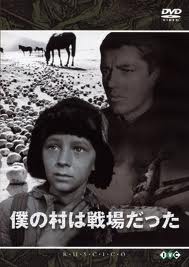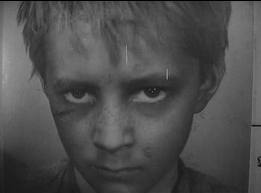 This movie is director Andrei Tarkovsky’s movie adaptation of Russian author Vladimir Bogomolov’s short story Ivan. Ivan—a young boy who became an orphan after losing his whole family including his parents in the Eastern Front during World War II when he was 12 years old—joins the partisans out of his hatred for Germany, and he later participates in the Soviet Army as a reconnaissance soldier; in the end, he is executed by the Nazis, ending his short life. There isn’t a particularly dramatic story development, but the movie keeps making a clear contrast between the beautiful and poetic scenes that flashback to the young boy’s memories of the peaceful days, and the harsh reality of the war spreading in front of the boy.
This movie is director Andrei Tarkovsky’s movie adaptation of Russian author Vladimir Bogomolov’s short story Ivan. Ivan—a young boy who became an orphan after losing his whole family including his parents in the Eastern Front during World War II when he was 12 years old—joins the partisans out of his hatred for Germany, and he later participates in the Soviet Army as a reconnaissance soldier; in the end, he is executed by the Nazis, ending his short life. There isn’t a particularly dramatic story development, but the movie keeps making a clear contrast between the beautiful and poetic scenes that flashback to the young boy’s memories of the peaceful days, and the harsh reality of the war spreading in front of the boy.
This movie’s characteristic is the beauty of the objet d’art (art object). Neither actual battle scenes nor German soldiers appear, and war is only symbolically expressed with gunshots and lights, like toy fireworks. Every objet d’art—water, darkness, light, lamps, ruins, the swamp, the beach, the well, horses, white birch trees, birds, apples, etc—is placed effectively and sometimes in a surprising location; also, the movement of people is shot from unexpected angles.
When Stalin died in 1953, the people under Soviet Union control in those days finally gained peace of mind, and Western culture rapidly flowed into the Soviet Union; new theories on movies and art were introduced into universities, and this movie was made during the period when a new generation of movie directors was being brought up. Andrei Tarkovsky was one of the young men of this new post-war generation. It is said he fawned over America, to the point of being criticized for it; he was very interested in modern America and obsessed with jazz. Also, he enthusiastically studied the directors that were considered great by Western countries in those days such as Jean-Luc Godard, Akira Kurosawa, Federico Fellini, Orson Welles, and Ingmar Bergman.
Rather than story and subject matter, this movie seems concerned with novel objet d’art and angles for filming; it seems that it was greatly influenced by La Nouvelle Vague (“the new wave”) swelling in France at that time. La Nouvelle Vague was a movie movement that happened in France in the 50s, and was led by French movie critics who bitterly criticized existing movie directors as being “dull,” and who enthusiastically declared, “We can make more interesting movies.” François Truffaut and Jean-Luc Godard were central figures.
In France, which was still scarred from the war in the 1950s and 60s, the youth tended to rebel strongly against adults and the establishment that caused the war. New movements were rising in many cultural areas, such as communism in politics, existentialism—led by Jean-Paul Sartre—followed by structuralism in the realm of philosophy, and La Nouvelle Vague within movies. The themes of these new movements included a feeling of decadence, eroticism, destructive acts, or nihilism without solutions. French culture heavily influenced Japan in the 60s, and a group called “Japan Nouvelle Vague” was even born in Japan, representative movie directors being Nagisa Oshima, Masahiro Shinoda, Shohei Imamura, Susumu Hani, Hiroshi Teshigahara, Yasuzo Masumura, and Koreyoshi Kurahara. They made movies with themes that had until then not often been the subject—such as juvenile delinquents, crimes, uninhibited sex, women living unnoticed in society, or bottom class people; also, they made movies that seemed to forsake the audience by being difficult to understand, and the audience began to consider them as “artists.”
La Nouvelle Vague movies were fresh in those times, but how are they when you watch them today? The novel techniques were imitated one after another by directors that followed after, and since everyone uses these methods now, viewers today may not understand why La Nouvelle Vague movies are considered revolutionary. Also, I wonder how many people today know the names Sartre and François Truffaut? Young Japanese people today might say about Sartre (pronounced “Sarutoru” in Japanese), “Sa-ru-to-ru, who? Is that someone who leaves (‘saru’) and takes things (‘toru’)?” But back in the 1960s, Sartre was so well-known in Japan that even a Japanese TV comedian referred to his name in a joke (“catch the monkey,” since “saru”=monkey, “toru”=catch) because the name “Sarutoru” sounds funny. I think it is certainly great that those of this movement pursued fresh methods and ideas 60 years ago, and since their methods are still kept alive in modern movies as mainstream methods, we could say that the core of La Nouvelle Vague is still alive today after all. Even now, we express the generalization, “French movies are difficult to understand, and they coldly cast aside the hearts of viewers.” Many modern French movies have a tone that is not La Nouvelle Vague, but there are also many French movies that are still based on the spirit of La Nouvelle Vague. We can say that La Nouvelle Vague was so influential that the basic tone of postwar French movies was defined by it.
As a result, this movie, Ivan’s Childhood, seems to raise interesting issues that Andrei Tarkovsky probably didn’t intend for.
 Ivan is a war orphan and, due to the murder of his family, changes from an innocent young boy to nihilistic young boy. The only emotion he believes in is “hatred.” He is not scared anymore, no matter what happens. He hates German soldiers, but can’t trust any adult anymore—German or Russian—because it was adults that caused this war.
Ivan is a war orphan and, due to the murder of his family, changes from an innocent young boy to nihilistic young boy. The only emotion he believes in is “hatred.” He is not scared anymore, no matter what happens. He hates German soldiers, but can’t trust any adult anymore—German or Russian—because it was adults that caused this war.
Ivan is killed in the war, but I wonder what would become of him if he survived? Maybe he would become an adult who hates the people in the generation above him. Germany and France, cruelly affected by the war, broke out in a violent anti-establishment movement in 1950s and 60s. Central to this movement was the generation who were children during the war, and this generation conveyed the feeling of hatred for the establishment to the generation born after the war. The change in the boy playing Ivan from being an innocent young boy with a happy smiling face to one with a dark face full of hatred—like an omen for the future—is very impressive in the movie.
